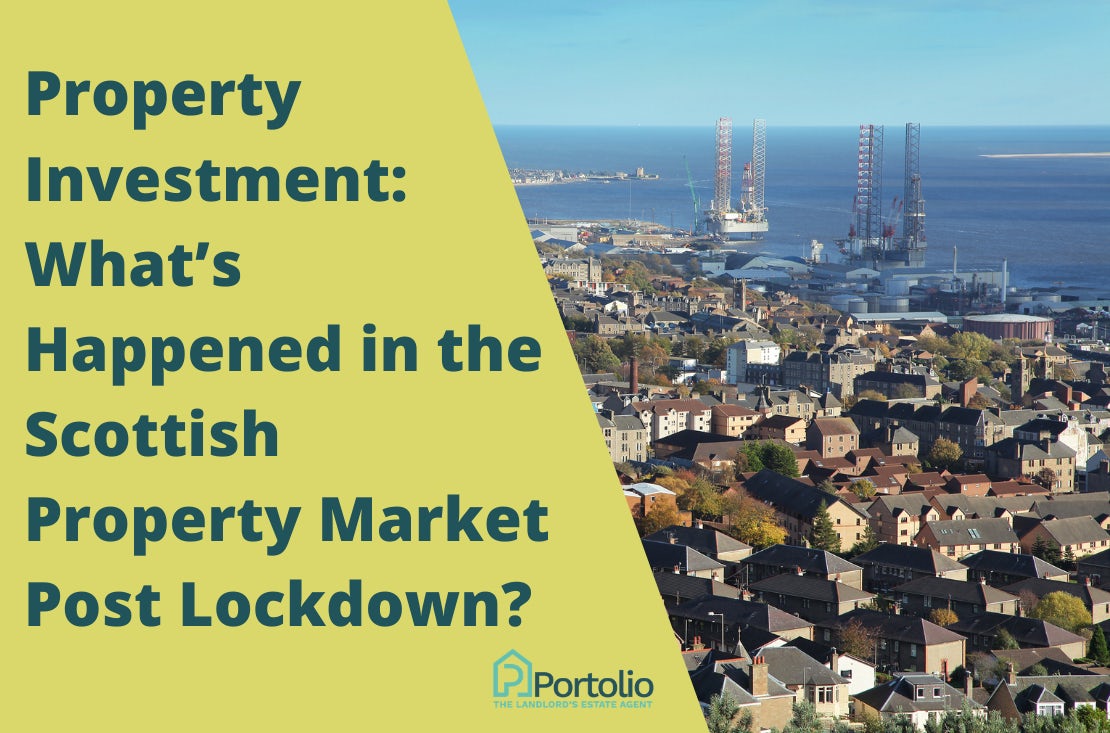It’s been an interesting six months in the Scottish property market since lockdown was lifted.
If you’re an active buy-to-let property investor, on the lookout for some good investment opportunities, you might have been put off by the extremely buoyant, and therefore highly competitive, homebuyer market.
At the same time, landlords looking to sell have had to carefully consider their options – but may be wondering what those are exactly, now that it’sbeen a few months since COVID.
For buy-to-let investors, there may also be the question of lending and how accessible mortgages are in these strange times – is it more of a challenge?
I was motivated to write this article, and give you an overview of all of the above, so you can gain a better understanding of what’s been happening across the whole of the Scottish property market.
You’ll also get some key insights and advice from us here at Portolio, Scotland’s only estate agent for landlords.
But first…
A quick overview of the general market
It’s been well-publicised that the homebuyer market has been very hot, and anything with a garden or a little extra space has been attracting offers as much as 40% above the home report value. Things have now calmed down a little, but demand is still higher than pre-COVID.
There’s been a real imperative to sell homes. In many cases, a change in lifestyle has dictated a change in property, or location. Interestingly, those who were in smaller flats and could only move to a bigger house if they sold, have so far been selling up quite easily.
This is mainly due to the help-to-buy schemes pushed by the government in order to aid first-time buyers onto the property ladder; and it’s all having a knock-on impact on the overall chain.
The property investment market became quite active again… at least, once the kids went back to school. The reality is that investors, unlike homebuyers, didn’t feel a desperate need to get immediately involved, but there was a feeling of pent up frustration due to overall inactivity.
We found there was a slight upturn upon the lifting of lockdown, but buy-to-let investors were still relatively quiet, before things picked up again in late August. We had more new buyers who weren’t previously aware of us come forward due to caution over the homebuyer market.
The Scottish property market post lockdown has seen values increase by roughly 2.3% over the past year, which is the greatest growth since 2018. However, this is still significantly lower than the increase we’ve seen between 2013 and 2016.
Here at Portolio, we also saw an increase in landlords wanting to sell, rising further in the second half of August, and continuing through September. Many more are turning to selling tenanted property due to it being the only option – thanks to the six-month waiting period imposed by the government.
TIP: We’ve written a specific blog about why landlords’ only option may be to sell with sitting tenants under the circumstances, which you can read here.
What this means for…
Buy-to-let investors
Currently, buy-to-let investors who buy through the traditional channels are competing with homebuyers, with properties going to closing dates – which is not something investors like to get involved in!
Bidding at closing dates can be such a waste of effort for canny property investors as, unlike a homebuyer, a buy-to-let investor will not get carried away and, thus, is beaten by a rival bidder’s super high offer.
TIP: If you’re looking for a buy-to-let investment property without competing with homebuyers, you might consider buying an already tenanted property that’s fully-compliant and gives you instant rental income from Day One of ownership. Check out our blog on all the benefits.

The number of first-time buyers, despite help offered by the government, is now coming down from the highs of July and August, but hasn’t yet dropped below pre-COVID levels yet – although it potentially will.
So, we can expect to see an impact on the property ladder where first time buyers aren’t coming in. Registration for government help has been extended to March 2021. After this period, we could see more demand for rental properties later on, which is better news for landlords.
There’s also an attraction to the level of flexibility renting can bring on a tenancy agreement, as opposed to a mortgage. With that in mind, demand for rental properties is likely to increase further over the next few years.
Landlords looking to sell
Due to the recent six months notice period, more and more properties are being sold with sitting tenants – and landlords are beginning to notice the benefits that come with doing so. These include maintaining rental income until completion of the sale, therefore avoiding the risk.
It also means tenants get to remain in their homes, whilst landlords can sell the property ‘as is’, with no void utility costs or any of the other hassle associated with selling the traditional way – whilst still getting a fair sales price.
TIP: For more detail on the benefits of selling a tenanted property, check out this blog we recently published.
Landlords selling this way can bring their property to the sales market now, rather than waiting six months when buyer demand may have changed and LBTT re-introduced. However, it’s worth bearing in mind that property investors aren’t prepared to pay over the home report value.
In contrast to homebuyers driven by emotional purchases, they’re being a little more cautious on price, driven by experience and cold, hard figures rather than emotions. This means landlords selling with sitting tenants need to be quite realistic on their sale price.
Some now-empty tenanted properties, due to the tenants moving out, may also be less likely to attract higher offers, as investors will be driven by what’s on paper right now.
Completion times
Timescales around completing on a property are now longer in the Scottish property market post lockdown.
Traditionally a cash buyer would take around four weeks for a transaction to complete, whereas lending would be around six to eight weeks. Now more people are working from home, this process can take longer.
There’s also the sheer volume of requests, which has a knock-on effect for solicitors, estate agents and mortgage companies dealing with volumes far greater than normal for this time of year.
Lending
Average mortgage rates are on the up, as of August 2020. This means that regardless of what your loan to value (LTV) is, you can expect to pay a little more on your mortgage again. There are also more mortgage products available, with more 80% LTV on fixed rate deals.
Some low-interest products are also being offered for first-time landlords by the likes of NatWest, who are offering a two-year fixed rate of around 1.35%. You can view more about the best fixed rate deals on buy-to-let mortgages via MoneyFacts.co.uk.

The rental market
The good news is that tenant demand since the rental market reopened has been strong in most parts of Scotland. The latest Citylets Quarterly Report records rents in Scotland increasing by 5.4% in Q3 of 2020.
However, the picture in Scotland’s two major cities is slightly different, with Glasgow reporting a 4.7% rent increase, and Edinburgh reporting a 0.8% decrease during this quarter. Demand is increasing for larger properties to facilitate home working, and access to outdoor space, should future lockdown restrictions be necessary.
The report also highlights increases in the average time to let, perhaps partly due to new COVID-19 viewing procedures and the increased in the number of properties on the market especially in Edinburgh.
The overall feedback from the letting agents who contributed to Citylets’ report seems to be that the market is buoyant, and they have a positive outlook moving into the end of the year and looking ahead to the start of 2021.
Tenants will come back, and the rental market will recover – but in the meantime, we’ve seen more void periods, rents dipping, and a loss of supply and demand.
What’s more, recent BSA research found that only 75% of tenants were confident they could meet their rent payments over the next six months. This could have a knock-on effect for landlords.
Other property trends we’ve noticed
Lending has become more difficult over the past few months, with both home buyers and investors finding it trickier to get mortgages over the line. It’s still possible for those determined enough to jump through a few more hoops, though.
We’ve also noticed that when it comes to tenanted property sales, there are more questions about the tenants and how they’re doing, employment, and how long they’re likely to stay in the property – some going so far as to ask for previous references.
This is because investors are understandably a little more on edge in the Scottish property market post lockdown, and looking for the reassurance that comes with knowing that tenants will be able to stay on in the property whilst still being able to afford their rent.
Advice from the property pros
Demand for rental properties over the next few years is likely to increase even further – with more tenants claiming housing benefit and Universal Credit. It’s fair to say that short-term predictions are a little greyer than the long-term outlook.
Due to the inherent nature of buy-to-let investment, it’s always going to be a long-term strategy. Each decade, property prices never fail to increase – at least, that’s the theory that’s held strong to this day. And over the past decade (2010 – 2019), we’ve seen the average selling price of Scottish propertyincrease by 23%.
However, the short-term outlook is invariably unpredictable, and could depend on factors such as a COVID vaccine becoming available.
Until the vaccine is introduced and made widely available, there may be a constant litany of circuit breakers, restrictions and localised lockdowns that will have an adverse effect on the property market – making things temporarily more unpredictable.
The takeaway from this is; if you’re buying a property just now at the value it’s truly worth, you should be fine in the long term. There are talks of a 4% – 10% dip in value over the next couple of years, but if this does indeed happen, we would expect a solid recovery over the following few years.
Remember that every area’s a little different, so bear in mind the market and area you’re operating in, and how that market is likely to be shaped in the years to come. Values in the cities will likely be fine, but in other areas, they may dip in the short-term.
There’s always a risk associated with any type of investment, so speak to a property professional who can advise.
In summary…
Thanks for taking the time to read. It’s been a chaotic time in the Scottish property market since lockdown, and as Scotland’s only estate agent for landlords, we’ll continue to keep our eye on the ball and monitor how things change over the coming months.
What are your thoughts on the past few months – or your predictions for the future?
If you’d like advice on buying or selling tenanted property, feel free to get in touch with us. We’re always happy to lend an ear, and offer some free, no-strings advice on your next steps.
It would be great to hear from you.
Written by Ross MacDonald, Director of Sales & Co-founder of Portolio
Get in touch on 07388 361 564 or email to [email protected]



Comments